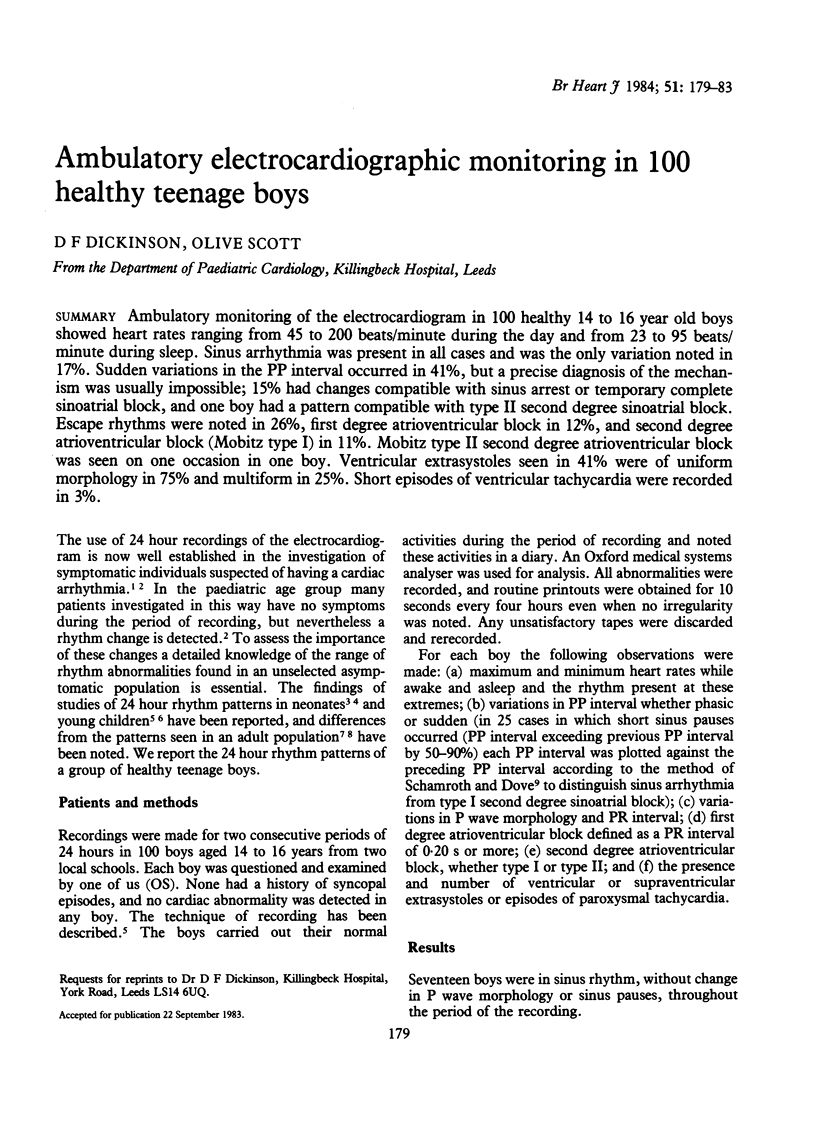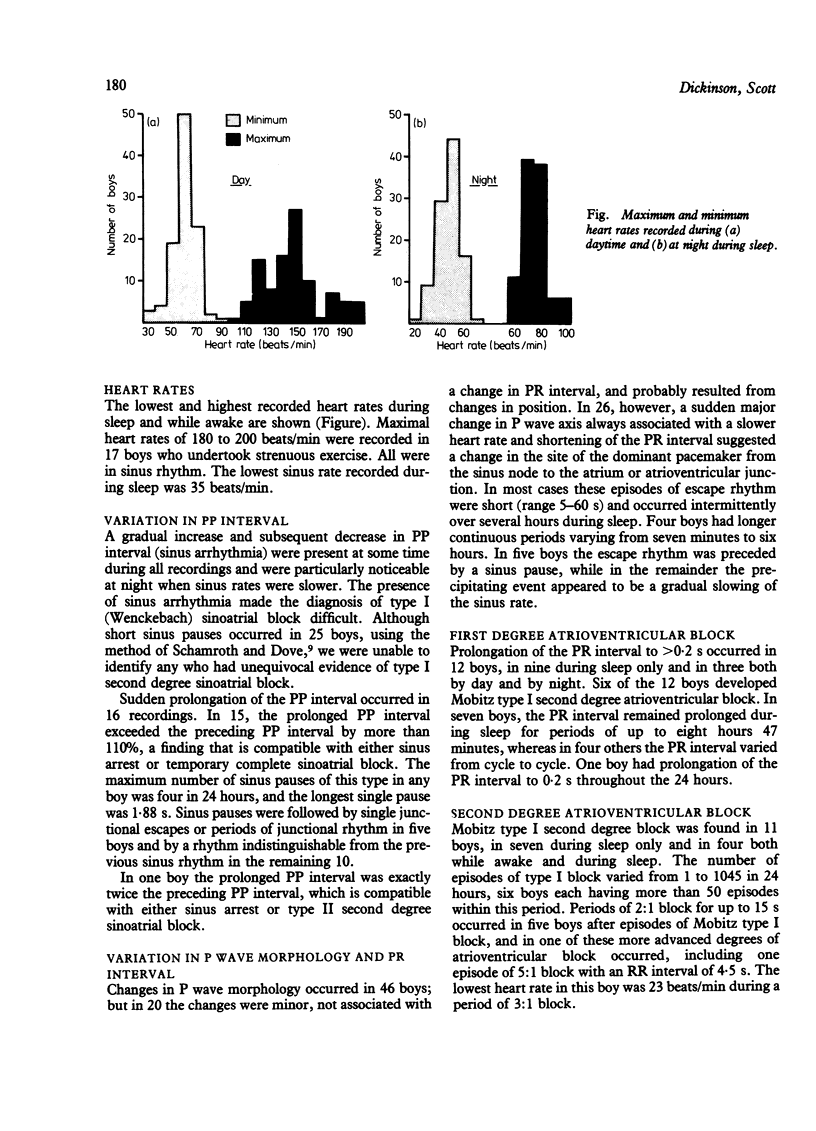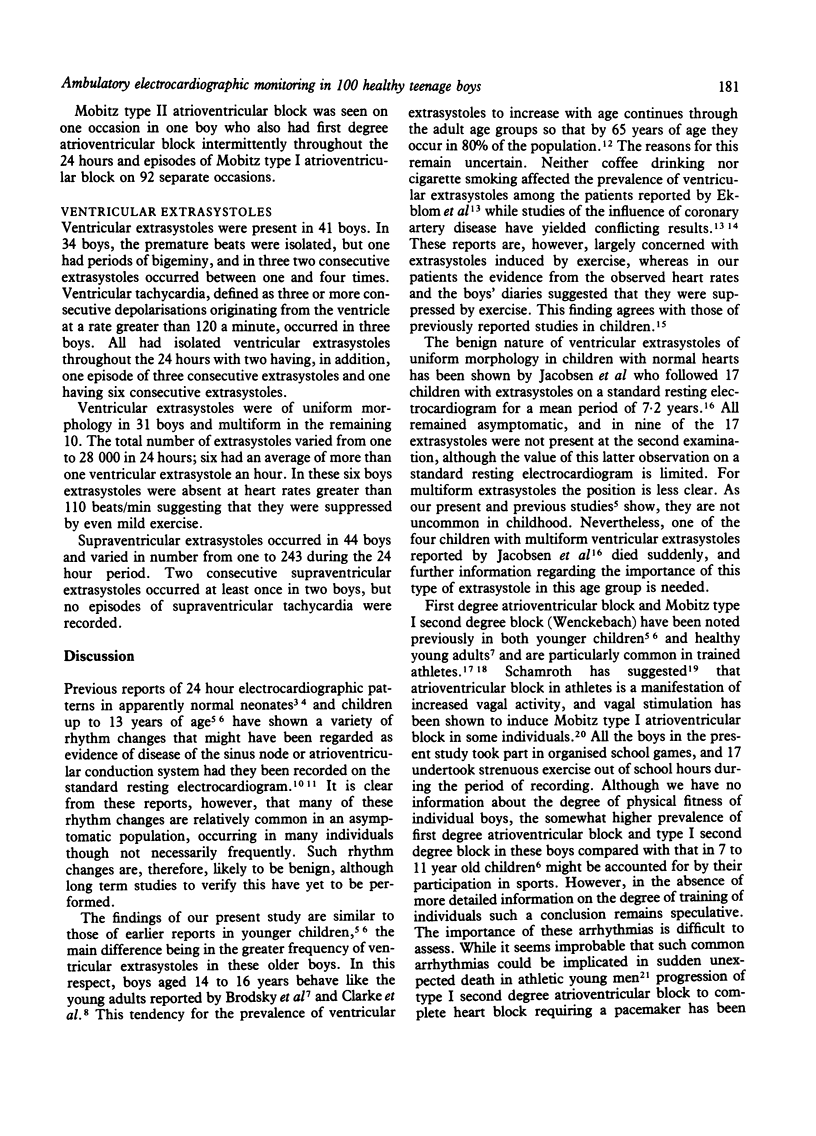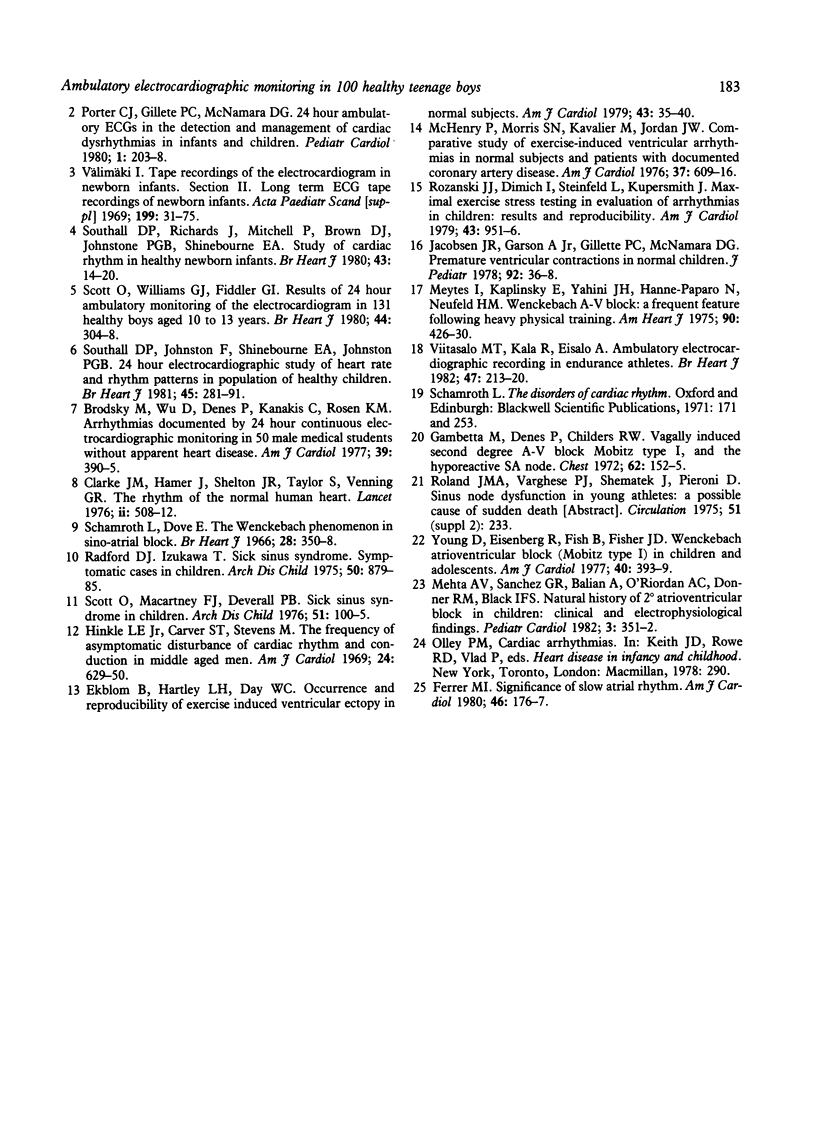Abstract
Ambulatory monitoring of the electrocardiogram in 100 healthy 14 to 16 year old boys showed heart rates ranging from 45 to 200 beats/minute during the day and from 23 to 95 beats/minute during sleep. Sinus arrhythmia was present in all cases and was the only variation noted in 17%. Sudden variations in the PP interval occurred in 41%, but a precise diagnosis of the mechanism was usually impossible; 15% had changes compatible with sinus arrest or temporary complete sinoatrial block, and one boy had a pattern compatible with type II second degree sinoatrial block. Escape rhythms were noted in 26%, first degree atrioventricular block in 12%, and second degree atrioventricular block (Mobitz type I) in 11%. Mobitz type II second degree atrioventricular block was seen on one occasion in one boy. Ventricular extrasystoles seen in 41% were of uniform morphology in 75% and multiform in 25%. Short episodes of ventricular tachycardia were recorded in 3%.
Full text
PDF




Selected References
These references are in PubMed. This may not be the complete list of references from this article.
- Brodsky M., Wu D., Denes P., Kanakis C., Rosen K. M. Arrhythmias documented by 24 hour continuous electrocardiographic monitoring in 50 male medical students without apparent heart disease. Am J Cardiol. 1977 Mar;39(3):390–395. doi: 10.1016/s0002-9149(77)80094-5. [DOI] [PubMed] [Google Scholar]
- Clarke J. M., Hamer J., Shelton J. R., Taylor S., Venning G. R. The rhythm of the normal human heart. Lancet. 1976 Sep 4;1(7984):508–512. doi: 10.1016/s0140-6736(76)90801-1. [DOI] [PubMed] [Google Scholar]
- Ekblom B., Hartley L. H., Day W. C. Occurrence and reproducibility of exercise-induced ventricular ectopy in normal subjects. Am J Cardiol. 1979 Jan;43(1):35–40. doi: 10.1016/0002-9149(79)90041-9. [DOI] [PubMed] [Google Scholar]
- Ferrer M. I. Significance of slow atrial rhythm. Am J Cardiol. 1980 Jul;46(1):176–177. doi: 10.1016/0002-9149(80)90621-9. [DOI] [PubMed] [Google Scholar]
- Gambetta M., Denes P., Childers R. W. Vagally induced second degree A-V block Mobitz type I, and the hyporeactive SA node. Chest. 1972 Aug;62(2):152–155. doi: 10.1378/chest.62.2.152. [DOI] [PubMed] [Google Scholar]
- Hinkle L. E., Jr, Carver S. T., Stevens M. The frequency of asymptomatic disturbances of cardiac rhythm and conduction in middle-aged men. Am J Cardiol. 1969 Nov;24(5):629–650. doi: 10.1016/0002-9149(69)90451-2. [DOI] [PubMed] [Google Scholar]
- Jacobsen J. R., Garson A., Jr, Gillette P. C., McNamara D. G. Premature ventricular contractions in normal children. J Pediatr. 1978 Jan;92(1):36–38. doi: 10.1016/s0022-3476(78)80066-3. [DOI] [PubMed] [Google Scholar]
- Lipski J., Cohen L., Espinoza J., Motro M., Dack S., Donoso E. Value of Holter monitoring in assessing cardiac arrhythmias in symptomatic patients. Am J Cardiol. 1976 Jan;37(1):102–107. doi: 10.1016/0002-9149(76)90507-5. [DOI] [PubMed] [Google Scholar]
- McHenry P. L., Morris S. N., Kavalier M., Jordan J. W. Comparative study of exercise-induced ventricular arrhythmias in normal subjects and patients with documented coronary artery disease. Am J Cardiol. 1976 Mar 31;37(4):609–616. doi: 10.1016/0002-9149(76)90403-3. [DOI] [PubMed] [Google Scholar]
- Meytes I., Kaplinsky E., Yahini J. H., Hanne-Paparo N., Neufeld H. N. Wenckebach A-V block: a frequent feature following heavy physical training. Am Heart J. 1975 Oct;90(4):426–430. doi: 10.1016/0002-8703(75)90421-4. [DOI] [PubMed] [Google Scholar]
- Radford D. J., Izukawa T. Sick sinus syndrome. Symptomatic cases in children. Arch Dis Child. 1975 Nov;50(11):879–885. doi: 10.1136/adc.50.11.879. [DOI] [PMC free article] [PubMed] [Google Scholar]
- Rozanski J. J., Dimich I., Steinfeld L., Kupersmith J. Maximal exercise stress testing in evaluation of arrhythmias in children: results and reproducibility. Am J Cardiol. 1979 May;43(5):951–956. doi: 10.1016/0002-9149(79)90358-8. [DOI] [PubMed] [Google Scholar]
- Schamroth L., Dove E. The Wenckebach phenomenon in sino-atrial block. Br Heart J. 1966 May;28(3):350–358. doi: 10.1136/hrt.28.3.350. [DOI] [PMC free article] [PubMed] [Google Scholar]
- Scott O., Macartney F. J., Deverall P. B. Sick sinus syndrome in children. Arch Dis Child. 1976 Feb;51(2):100–105. doi: 10.1136/adc.51.2.100. [DOI] [PMC free article] [PubMed] [Google Scholar]
- Scott O., Williams G. J., Fiddler G. I. Results of 24 hour ambulatory monitoring of electrocardiogram in 131 healthy boys aged 10 to 13 years. Br Heart J. 1980 Sep;44(3):304–308. doi: 10.1136/hrt.44.3.304. [DOI] [PMC free article] [PubMed] [Google Scholar]
- Southall D. P., Johnston F., Shinebourne E. A., Johnston P. G. 24-hour electrocardiographic study of heart rate and rhythm patterns in population of healthy children. Br Heart J. 1981 Mar;45(3):281–291. doi: 10.1136/hrt.45.3.281. [DOI] [PMC free article] [PubMed] [Google Scholar]
- Southall D. P., Richards J., Mitchell P., Brown D. J., Johnston P. G., Shinebourne E. A. Study of cardiac rhythm in healthy newborn infants. Br Heart J. 1980 Jan;43(1):14–20. doi: 10.1136/hrt.43.1.14. [DOI] [PMC free article] [PubMed] [Google Scholar]
- Viitasalo M. T., Kala R., Eisalo A. Ambulatory electrocardiographic recording in endurance athletes. Br Heart J. 1982 Mar;47(3):213–220. doi: 10.1136/hrt.47.3.213. [DOI] [PMC free article] [PubMed] [Google Scholar]
- Young D., Eisenberg R., Fish B., Fisher J. D. Wenckebach atrioventricular block (Mobitz type I) in children and adolescents. Am J Cardiol. 1977 Sep;40(3):393–399. doi: 10.1016/0002-9149(77)90161-8. [DOI] [PubMed] [Google Scholar]


